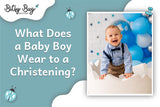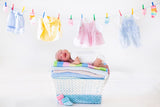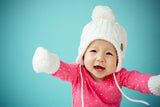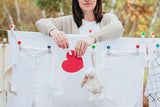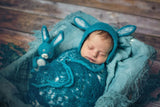What Should Baby Wear To Sleep In Winter
Being a young inexperienced parent can cause a lot of stress and anxiety. It’s especially common during the chilly winter months when your baby’s most prone to catching a cold. One frequent worry most parents have is that their little ones might get cold during the night. So, what should baby wear to sleep in winter?
Here you can explore the different clothing options, discover the meaning behind the TOG rating, and learn the key safety points every parent should know.
Continue reading to discover the best ways to keep your baby warm and the best practices for the occasion!

Source: shutterstock.com / Photo Contributor: Dima Sobko
What Should Baby Wear to Sleep in Winter?
When it comes to the best babywear suitable for winter, the clothing choice mostly depends on your baby’s age and the overall temperature in your region.
Until the age of 11 months, your little one can’t regulate their body temperature. That’s why during this period, you have to keep a close eye on what they’re wearing and choose TOG-rated clothing suitable for the weather.
You should also try layering different types of clothing and see which works best for you and your little one. If you need cute newborn baby girl clothes, you can check out our newest collection for inspiration.
TOG rating
The Thermal Overall Grade, also known as TOG, is meant to measure the insulation and warmth of bedding and sleepwear. One thing to remember when choosing TOG-rated clothing is that lighter fabrics have lower ratings.
Therefore, if you’re shopping for winter wear, it’s best to choose clothes with a higher rating to ensure they’re better insulated.
To make things easier, choose 1.0 TOG for rooms with temperatures between 69.8 and 75.2 °F. In case the temperature ranges from 62.6 to 73.4 °F, it's best to use 2.5 TOG-rated clothing.
Swaddling
Every new parent should learn how to swaddle their little one for sleepy time. Since babies have a startle reflex known as Moro, this technique helps control the sudden jerks in their bodies. For this reason, swaddle bags are used to restrict their arms from unexpected movements that might wake them up.
Since even the slightest noise or light can trigger this reflex, the easiest solution is to use a swaddle bag. You can also find ones with suitable TOG ratings that will keep your babies both comfortable and warm during the night.
Once your little one starts rolling over on their own, you can replace the swaddle with a sleeping bag.

Source: shutterstock.com / Photo Contributor: Oksana Kuzmina
Appropriate clothing
When choosing the appropriate clothing for your baby, you have to keep the TOG rating and swaddling in mind.
Furthermore, you should never forget the importance of layering. Since your baby will most likely sleep for around 16 hours a day, you have to choose the right sleepwear.
Layer and swaddle combination
If you plan on swaddling your little one, you won’t need to worry about using many layers. Make sure to check the TOG rating for both the swaddle bag and clothing to avoid overheating.
It’s usually enough to use a 0.2 TOG-rated long sleeve layer and a 1.0 TOG-rated swaddle bag for room temperatures between 71.6 and 75.2 °F. If the warmth drops between 60.8 and 68 °F, use a combination of a 1.0 TOG-rated layer and a 2.5 TOG-rated swaddle bag.
If you’re still worried that your little one may get cold, numerous bodysuits and singlets have TOG ratings. Pick the ones that seem the most appropriate for you and use them underneath the long-sleeve layer.
Layering tips
When it comes to layering, there’s no strict guide to follow since it all comes down to common sense. If your little one feels cold, add a layer; if they feel hot, remove one.
Here’s a simple example you can follow:
- Bottom layer - Use organic cotton singlets or grow suits.
- Middle layer - Cardigans go well with grow suits, while leggings, bodysuits, and rompers work best for singlets.
- Top layer - This usually comes down to knitwear, jackets, and coats, as well as accessories like mittens, beanies, and boots.
Another method suitable for babies younger than 18 months is the “plus one” layering. It's used during the winter and is as simple as it gets. Just dress the little one the same way you dress, and then add another layer on them.

Source: shutterstock.com / Photo Contributor: Re_sky
Things to Consider for Your Baby During the Winter
After you’ve decided on the clothing styles and techniques to keep your baby warm, you should know two more key facts. These include the overall room temperature and crib setup. They both are important to your baby’s safety, and you should never undermine them.
Room temperature
First off, we’ll start with the ideal nursery room temperature. Since your little one will spend most of its time in this room, keep it between 68 and 72 °F. So, take out the thermometer and frequently check the area’s warmth.
There are two main reasons behind making a fuss about this issue. The first is because your baby might get restless during their sleep if they get too hot or cold. When maintaining the right temperature, you allow your baby to get a good night’s rest, which also means that you’ll get some well-deserved rest.
The second reason is to reduce the risk of SIDS and other health issues. Since sudden infant death syndrome has been closely related to overheating, keeping an ideal room temperature is necessary.
Another thing to watch out for regarding SIDS is crib safety, which brings us to our next section.
Crib and bedding
As new parents, you want to prepare a safe and hazard-free sleeping area for your little one. Picking the right crib and setting it up should be done with extra care. During this process, you’ll have to pay attention to several details, which include:
- Choosing a tight-fitting mattress;
- Using a bottom sheet specifically designed for cribs;
- Avoiding pillows, stuffed animals, and comforters inside the crib;
- Avoiding the use of a loose blanket to reduce the risk of suffocation;
- Checking the crib for any missing components and gaps where your baby can get stuck.
By following these simple instructions, you’ll ensure both your child’s safety and a restless night.

Source: shutterstock.com / Photo Contributor: Anna Koldunova
How to Know If Your Baby is Cold During the Night
The best way to determine if your little one is cold at night is by doing a simple touch test. Simply place your hand on the baby’s belly or back of the neck to see if their skin feels warm. These are the best parts to feel the core temperature since the arms and legs are naturally colder.
When you do this test, your baby’s skin should only feel warm. If they’re sweaty, it’s a sign that you should remove a clothing layer because they’re feeling hot. On the other hand, if the skin feels a bit cold, it’s best to add another layer to keep them warm.
Conclusion
What should baby wear to sleep in winter? Even though dressing your little one for cold winter nights may seem scary, it’s not that hard. Just remember to check the baby’s and the room’s temperature, ensure the crib is safe, and use the appropriate TOG-rated clothing.
We hope this article has helped you with baby sleep clothes during winter and the best practices for it. Don’t forget to enjoy these moments of early parenthood to the fullest since babies do grow up fast!


